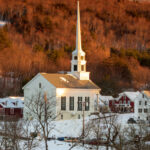The Best Spring Break Skiing in the Pacific Northwest


Itching to get in a few more runs before you stow your gear? The Pacific Northwest receives some of the heaviest snowfall in the United States. As the Gulf of Alaska creates storms, the Jet Stream track generally favours the Pacific Northwest, so intensified storms generally run right into Oregon and Washington. This means there will be plenty of powder well into March and April, and plenty of spring break skiing.
Conveniently located within a short drive of some of the best ski resorts, the major metropolitan areas of Seattle and Portland just happen to be in the exact right spot to consistently get nailed by those big Alaskan storms. Here skiing extends well into the spring and since the area is not particularly heavy on tourists, you will be surprised at how economical lift tickets are.
Here’s our pick of the best spring break skiing in the Pacific Northwest, with minimal to no lift lines, longer bluebird days, closer to the lifts parking and special deals on ticket prices.

Timberline Lodge Ski Area
Timberline Lodge, Oregon (3,690 vertical feet)
Mt. Hood, just east of Portland, is Oregon’s tallest peak, boasting a triplet of diverse resorts and the only ski area in North America open all 12 months of the year. With its lifts running all year, Timberline draws professional athletes and gear testers from around the world. Timberline’s 41 runs, 1,415 acres of terrain and freestyle terrain park offer tons of vertical inspiration, its Palmer lift reaching high enough to keep shredders on snow throughout the spring.
Fans of long runs should hit the slopes from Timberline’s classic 55,000-sq-ft lodge. Constructed in 1937 and designated a National Historic Landmark, Timberline Lodge is the only ski-in, ski-out resort in Oregon. The resort sells discounted spring passes, as well as spring lodging specials.
For details and up-to-date pricing, visit the Timberline Lodge & Ski Area website .

Mt. Hood Meadows
Parkdale, Oregon (2,777 vertical feet)
Near Timberline, Mt. Hood Meadows features 2,150 acres of terrain and 85 runs with a lift-served elevation of 7,300 feet on the wind-protected south-east side of the mountain. The mountain sees an average of 430 inches of fresh powder per year. So you can shred an array of steeps, chutes, winding groomers and a three-mile-long run, served by six high-speed quads.
Gated access allows anyone with backcountry savvy a shot at the pulse-pounding cliffs, gullies and glades in Mt. Hood’s Heather Canyon, Clark Canyon and Private Reserve areas.
For details and up-to-date pricing, visit the Mt. Hood Meadows website .

Mount Hood Skibowl
Government Camp, Oregon (1,500 vertical feet)
The third of Mt Hood’s resorts, Skibowl ’s outstanding mid-sized, 60-run ski area caters to a diverse crowd with the state’s most abundant collection of black diamond runs, home to the nation’s largest night skiing operation and the Northwest’s hardcore tubing hotbed. After a few hours on the slopes, drop in to the Warming Hut for a mid-mountain snack. Built on a shelf between the upper and lower bowls, the wood glow of this historic stop-off point is a major draw.
An Unlimited Spring Pass provides access any time the lifts are running until the end of the ski season.
For details and up-to-date pricing, visit the Mount Hood Skibowl website .

Mount Bachelor
Bend, Oregon (3,365 vertical feet)
Because the nordic ski trails here sit at about 6,000 feet above sea level, Mount Bachelor enjoys the longest groomed nordic season in North America. Surrounded by Deschutes National Forest, Bachelor’s 4,323 skiable acres have 101 runs and eleven lifts. These include seven high-speed quads, opening up 35 miles of trails. Take the high-speed Summit Express chairlift to enjoy full-circle views. You’ll be able to scope out your route from the pristine summit down wide bowls and tree-lined swaths at the front of the mountain, or around the back through powder snowfields.
The Sunchaser Spring Pass offers up to 58 days of skiing or snowboarding from late March through May, paying for itself after just three visits.
For details and up-to-date pricing, visit the Mount Bachelor website .

Crystal Mountain
Crystal Mountain, Washington (3,100 vertical feet)
Less than a two-hour drive from Seattle, Crystal Mountain Resort lies on the sunny side of Mt. Rainier. Washington’s largest ski resort, with great on- and off-piste skiing, boasts 2,600 acres of terrain suited to every ability. Steep and pocketed with rocks and trees, some 57 runs offer multiple ways to ski from the peak of the gondola all the way down to the mountain base. Expect a sublime selection of bowls, moguls, groomers, chutes and glades.
Crystal Mountain is especially primed for skiers between February and April when the resort has the most snow pack and coverage. Keep your eyes peeled for discounted lift tickets, which are often offered for late March through mid-April.
For details and up-to-date pricing, visit the Crystal Mountain website.

Mission Ridge
Wenatchee, Washington (2,250 vertical feet)
Tucked into the basin on the eastern side of the Cascade Mountains, Mission Ridge ’s 2,000 sprawling, sun-filled acres and 36 runs offer up shred-worthy terrain for intermediate and advanced riders (the majority of trails are wide, fast blues). For beginners there are spacious and gentle groomers.
The resort gets its name from a B-24 Liberator Bomber that crashed here. In late September of 1944, the B-24 was conducting a night training mission out of Walla Walla Army Air Base and, unfortunately, veered off course during a storm. Remains of the crew and wreckage were recovered, but the bulk of the bomber was left on the mountain. You’ll find a memorial to the bomber crew and a section of the wing displayed on the slopes. Legend has it that rubbing the wing brings snow to the resort.
For details and up-to-date pricing, visit the Mission Ridge
website.




